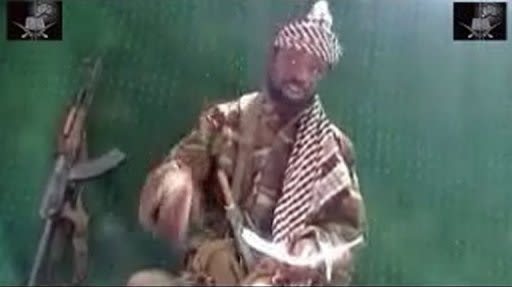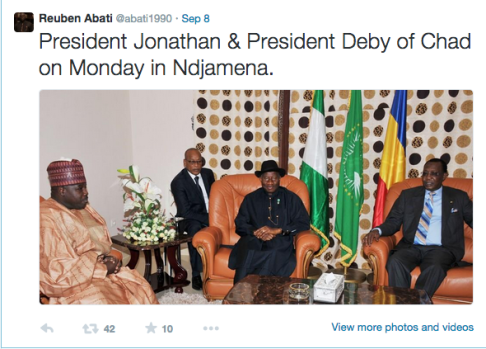Boko Haram, Abubakar Shekau(s) WARNING images of dead bodies
http://www.usip.org/publications/why-do ... boko-haram
It is not clear when Boko Haram came into being. A common account of the group’s origin
traces it to 2002, when Mohammed Yusuf, a charismatic preacher, became its leader. To
Nigeria’s intelligence community, however, its true historical roots hark back to 1995, when
Abubakar Lawan established the Ahlulsunna wal’jama’ah hijra, or Shabaab group (Muslim Youth
Organization), in Maiduguri, Borno state.10 The group flourished as a nonviolent movement
until 2002, when Yusuf assumed leadership. It has appeared over time under various names,
such as the Muhajirun, Hijrah, Ahlis Sunnah wal Jama’a, Yusufiyyah, and Nigerian Taliban.
Boko Haram’s ideology is premised on an extreme Islamic teaching that rejects most
Western ideas and institutions as un-Islamic. This rejection earned the group its popular
name: Boko Haram literally means “Western education is forbidden.” However, the group
prefers to be called by its real name, Jama’atu Ahlissunnah Lidda’awati wal Jihad, meaning
“people committed to the propagation of the Prophet’s teachings and jihad.” Its core objective
is to replace the secular Nigerian state with a regime adhering to strict Islamic sharia
law, applicable throughout the entire country.
aw, applicable throughout the entire country.
Boko Haram draws its members mainly from disaffected youth, unemployed high school
and university graduates, and destitute children, mostly from but not limited to northern
Nigeria. Its membership also includes some wealthy, educated, and influential people. The
group is known to sustain its operations through diverse sources of funding, including membership
dues, donations from politicians, financial assistance from foreign terrorist groups,
raiding of banks, and ransom from kidnapping. It also has extorted money from residents
of areas it has controlled, as well as from wealthy persons whom they have intimidated into
paying protection fees to avoid being attacked by them.
Its history of violence dates to December 24, 2003, when it attacked police stations and
public buildings in the towns of Geiam and Kanamma in Yobe state. Members occupied two
buildings for several days, hoisting the flag of Afghanistan’s Taliban movement over the
camps. Soldiers and police removed them only after killing eighteen of them and arresting
dozens more.11 The sect had earlier established a base they called Afghanistan in Kanamma
village in northern Yobe state. In Maiduguri, Mohammed Yusuf was already drawing youth
to him through his preaching about the excesses of government officials, culminating in his
frequent declaration of secular education as haram (forbidden) to Muslims.12 His preaching
attracted youth from Yobe and Borno states, as well as neighbouring countries—Cameroon,
Chad, and Niger.
The activities of the group became even more worrisome in 2004 when students, especially
in tertiary institutions in Borno and Yobe states, withdrew from school, tore up their
certificates, and joined the group. On September 21, 2004, members attacked the Bama
and Gworza police stations in Borno state, killing several policemen and stealing arms and
ammunition. The group continued with intermittent hit-and-run attacks on security posts
in some parts of Borno and Yobe until the July 2009 antigovernment uprising in Nigeria.
The remote cause of the July 2009 revolt is often traced to the fatal shootings of sect
members on June 11, 2009, by security forces involved in Operation Flush,13 following
a clash with sect members for not wearing crash helmet while on their motorbikes for a
funeral procession. In retaliation, the members attacked and destroyed the Dutsen Tanshi
police station on July 26. This raised the curtain for a wave of unrest that swept through
Bauchi, Borno, Kano, Katsina, and Yobe states. The revolt ended on July 30, 2009, when
Mohammed Yusuf was finally captured in his residence in Maiduguri. After a few hours in
police custody, the police killed Yusuf extrajudicially; police officials claimed that he was
trying to escape. Over eight hundred people, mainly sect members, were killed during the
revolt, and hundreds more were arrested. Nigerian authorities’ methods in repressing the
2009 revolt proved to be crucial in the deadly escalation of Boko Haram’s violent attacks. The
group went underground and later adopted Yusuf’s hard-line top deputy, Abubakar Shekau,
as the sect’s new spiritual leader. It subsequently developed new violent tactics: bombings,
targeted assassinations, ambushes, drive-by shootings, and slitting victims’ throats.
Since the July 2009 revolt, the sect has evolved into a more dynamic and decentralized
organization, capable of changing and combining tactics as well as expanding or reordering
target selection. Boko Haram has attacked a variety of groups, including security agents,
Christians, traditional rulers, politicians, schoolchildren and teachers, Islamic scholars,
public servants, traders, and, lately, anyone who is not a member. Most of the attacks have
occurred in Maiduguri, the capital city of Borno state. The group also has claimed responsibility
for several attacks in Adamawa, Bauchi, Gombe, Jigawa, Kaduna, Kano, Kogi, Niger,
Plateau, and Yobe states, as well as the Federal Capital Territory, Abuja. The group leapt
onto the world’s agenda in August 2011 when it bombed the UN compound in Abuja, killing
twenty-three people.14 In January 2012, President Goodluck Jonathan declared a state of
emergency in fifteen local governments across four states in the north. By July 2012, when
the state of emergency ceased, the security crisis had not been addressed. In May 2013,
President Jonathan again declared a state of emergency in the three most affected states
of Adamawa, Borno, and Yobe.
Reports show that the foot soldiers of the sect consist predominantly of young people
who are ready to fight and die for the new cause they have been made to believe in. Based
on the analysis of 144 arrested Boko Haram members, a recent study has shown that the
median age of the group’s members is thirty years.15 Its young followers, who previously
used local weapons in attacks, have become highly radicalized individuals willing to carry out
suicide bombings in pursuit of martyrdom—a phenomenon that never occurred in Nigeria
until the June 16, 2011, suicide attack on Abuja’s police headquarters by a thirty-five-year-old
Boko Haram member, Mohammad Manga.
It is not clear when Boko Haram came into being. A common account of the group’s origin
traces it to 2002, when Mohammed Yusuf, a charismatic preacher, became its leader. To
Nigeria’s intelligence community, however, its true historical roots hark back to 1995, when
Abubakar Lawan established the Ahlulsunna wal’jama’ah hijra, or Shabaab group (Muslim Youth
Organization), in Maiduguri, Borno state.10 The group flourished as a nonviolent movement
until 2002, when Yusuf assumed leadership. It has appeared over time under various names,
such as the Muhajirun, Hijrah, Ahlis Sunnah wal Jama’a, Yusufiyyah, and Nigerian Taliban.
Boko Haram’s ideology is premised on an extreme Islamic teaching that rejects most
Western ideas and institutions as un-Islamic. This rejection earned the group its popular
name: Boko Haram literally means “Western education is forbidden.” However, the group
prefers to be called by its real name, Jama’atu Ahlissunnah Lidda’awati wal Jihad, meaning
“people committed to the propagation of the Prophet’s teachings and jihad.” Its core objective
is to replace the secular Nigerian state with a regime adhering to strict Islamic sharia
law, applicable throughout the entire country.
aw, applicable throughout the entire country.
Boko Haram draws its members mainly from disaffected youth, unemployed high school
and university graduates, and destitute children, mostly from but not limited to northern
Nigeria. Its membership also includes some wealthy, educated, and influential people. The
group is known to sustain its operations through diverse sources of funding, including membership
dues, donations from politicians, financial assistance from foreign terrorist groups,
raiding of banks, and ransom from kidnapping. It also has extorted money from residents
of areas it has controlled, as well as from wealthy persons whom they have intimidated into
paying protection fees to avoid being attacked by them.
Its history of violence dates to December 24, 2003, when it attacked police stations and
public buildings in the towns of Geiam and Kanamma in Yobe state. Members occupied two
buildings for several days, hoisting the flag of Afghanistan’s Taliban movement over the
camps. Soldiers and police removed them only after killing eighteen of them and arresting
dozens more.11 The sect had earlier established a base they called Afghanistan in Kanamma
village in northern Yobe state. In Maiduguri, Mohammed Yusuf was already drawing youth
to him through his preaching about the excesses of government officials, culminating in his
frequent declaration of secular education as haram (forbidden) to Muslims.12 His preaching
attracted youth from Yobe and Borno states, as well as neighbouring countries—Cameroon,
Chad, and Niger.
The activities of the group became even more worrisome in 2004 when students, especially
in tertiary institutions in Borno and Yobe states, withdrew from school, tore up their
certificates, and joined the group. On September 21, 2004, members attacked the Bama
and Gworza police stations in Borno state, killing several policemen and stealing arms and
ammunition. The group continued with intermittent hit-and-run attacks on security posts
in some parts of Borno and Yobe until the July 2009 antigovernment uprising in Nigeria.
The remote cause of the July 2009 revolt is often traced to the fatal shootings of sect
members on June 11, 2009, by security forces involved in Operation Flush,13 following
a clash with sect members for not wearing crash helmet while on their motorbikes for a
funeral procession. In retaliation, the members attacked and destroyed the Dutsen Tanshi
police station on July 26. This raised the curtain for a wave of unrest that swept through
Bauchi, Borno, Kano, Katsina, and Yobe states. The revolt ended on July 30, 2009, when
Mohammed Yusuf was finally captured in his residence in Maiduguri. After a few hours in
police custody, the police killed Yusuf extrajudicially; police officials claimed that he was
trying to escape. Over eight hundred people, mainly sect members, were killed during the
revolt, and hundreds more were arrested. Nigerian authorities’ methods in repressing the
2009 revolt proved to be crucial in the deadly escalation of Boko Haram’s violent attacks. The
group went underground and later adopted Yusuf’s hard-line top deputy, Abubakar Shekau,
as the sect’s new spiritual leader. It subsequently developed new violent tactics: bombings,
targeted assassinations, ambushes, drive-by shootings, and slitting victims’ throats.
Since the July 2009 revolt, the sect has evolved into a more dynamic and decentralized
organization, capable of changing and combining tactics as well as expanding or reordering
target selection. Boko Haram has attacked a variety of groups, including security agents,
Christians, traditional rulers, politicians, schoolchildren and teachers, Islamic scholars,
public servants, traders, and, lately, anyone who is not a member. Most of the attacks have
occurred in Maiduguri, the capital city of Borno state. The group also has claimed responsibility
for several attacks in Adamawa, Bauchi, Gombe, Jigawa, Kaduna, Kano, Kogi, Niger,
Plateau, and Yobe states, as well as the Federal Capital Territory, Abuja. The group leapt
onto the world’s agenda in August 2011 when it bombed the UN compound in Abuja, killing
twenty-three people.14 In January 2012, President Goodluck Jonathan declared a state of
emergency in fifteen local governments across four states in the north. By July 2012, when
the state of emergency ceased, the security crisis had not been addressed. In May 2013,
President Jonathan again declared a state of emergency in the three most affected states
of Adamawa, Borno, and Yobe.
Reports show that the foot soldiers of the sect consist predominantly of young people
who are ready to fight and die for the new cause they have been made to believe in. Based
on the analysis of 144 arrested Boko Haram members, a recent study has shown that the
median age of the group’s members is thirty years.15 Its young followers, who previously
used local weapons in attacks, have become highly radicalized individuals willing to carry out
suicide bombings in pursuit of martyrdom—a phenomenon that never occurred in Nigeria
until the June 16, 2011, suicide attack on Abuja’s police headquarters by a thirty-five-year-old
Boko Haram member, Mohammad Manga.
















